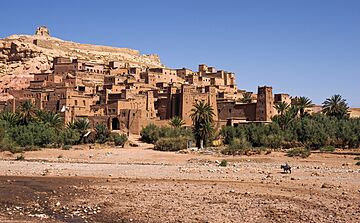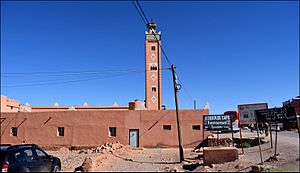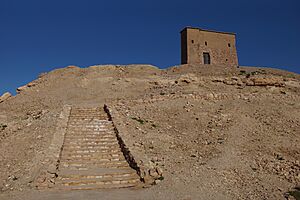Aït Benhaddou facts for kids
| UNESCO World Heritage Site | |
|---|---|

Aït Benhaddou
|
|
| Official name | Ksar of Ait-Ben-Haddou |
| Location | Morocco |
| Criteria | Cultural: (iv), (v) |
| Inscription | 1987 (11th Session) |
| Area | 3.03 ha (0.0117 sq mi) |
| Buffer zone | 16.32 ha (0.0630 sq mi) |
Aït Benhaddou is a famous old ksar (pronounced "k-sar"). A ksar is a special kind of fortified village. It's located in Morocco, a country in North Africa. This village sits along an ancient trade route. This route once connected the Sahara desert with the city of Marrakesh.
Aït Benhaddou is a fantastic example of Moroccan buildings. These buildings are made from a special kind of clay earth. Because of its unique history and architecture, UNESCO made it a World Heritage Site in 1987. This means it's a very important place that needs to be protected.
Contents
The Story of Aït Benhaddou
People started building forts at this spot way back in the 11th century. This was during the time of the Almoravid dynasty. The buildings you see today are from the 17th century or later. But they were built using the same old methods.
The village was very important because of where it was. It was in the Ounila Valley, on a main trans-Saharan trade route. This route led to the Tizi n'Tichka pass. This pass was one of the few ways to cross the Atlas Mountains. It connected Marrakesh to the Dra'a Valley, which is near the Sahara desert. Many other fortified villages, called kasbahs and ksour, were also along this route.
Life in the Ksar Today
Today, only a few families still live inside the old ksar. Over time, the valley became less important for trade. So, most people moved to modern homes. These new homes are in a village across the river.
Most local people now earn money from farming. They also work in tourism, helping visitors explore the old village. In 2011, a new bridge was built. This bridge connects the old ksar to the modern village. It makes it easier for tourists to visit. It also hopes to encourage people to move back into the historic homes.
In September 2023, an earthquake hit southern Morocco. Aït Benhaddou was affected. Reports said there were cracks and some parts of buildings collapsed. There was a risk of more damage.
Exploring Aït Benhaddou
Inside the Fortified Village
The ksar is built on the side of a hill. The Ounila River flows nearby. All the buildings are close together inside a strong defensive wall. This wall has towers at the corners and a main gate.
Inside, you'll find homes of different sizes. Some are small, while others are tall with towers. Some buildings have cool patterns on their upper parts. The village also has public buildings. These include a mosque (a place of worship), a caravanserai (a place for travelers to rest), and several kasbahs (castle-like homes). There's also a shrine for a holy person named Sidi Ali or Amer.
At the very top of the hill, you can see the remains of a large, fortified granary. This was a place to store grain safely. There's also a public square, a Muslim cemetery, and a Jewish cemetery. Outside the walls, people used to grow and process grain.

How it was Built: Amazing Materials
The buildings in Aït Benhaddou are made from natural materials. These include rammed earth, adobe, clay bricks, and wood. Rammed earth, also called pisé, is a very practical and cheap material. It's made by pressing earth and mud together. Sometimes other things are mixed in to help it stick.
This material needs regular care. Rain can slowly wear it away over time. So, if a village made of rammed earth is left empty, it can start to crumble in just a few decades. In Aït Benhaddou, the taller buildings used rammed earth for their lower floors. The upper floors were made of lighter adobe. This helped to reduce the weight on the walls.
Protecting Aït Benhaddou's Past
Aït Benhaddou has been greatly repaired and cared for in recent times. This is partly because Hollywood movies often film there. Also, it became a UNESCO World Heritage Site in 1987.
UNESCO says that the ksar has kept its original look and materials. This is because people still use traditional building methods. They avoid using new materials like concrete. A special local group helps to watch over and manage the site.
A Star on Screen: Films at Aït Benhaddou
Many movies and TV shows have been filmed at Aït Benhaddou. Its unique look makes it a popular spot! Here are some of them:
- Lawrence of Arabia (1962)
- Sodom and Gomorrah (1963)
- Oedipus Rex (1967)
- The Man Who Would Be King (1975)
- The Message (1976)
- Jesus of Nazareth (1977)
- Time Bandits (1981)
- Marco Polo (1982)
- The Jewel of the Nile (1985)
- The Living Daylights (1987)
- The Last Temptation of Christ (1988)
- The Sheltering Sky (1990)
- Kundun (1997)
- The Mummy (1999)
- Gladiator (2000)
- Alexander (2004)
- Kingdom of Heaven (2005)
- Babel (2006)
- One Night with the King (2006)
- Prince of Persia (2010)
- Son of God (2014)
- Queen of the Desert (2015)
- A Life On Our Planet (2020)
Aït Benhaddou was also used in parts of the TV series Game of Thrones. It also appeared in the Brazilian TV series O Clone and The Amazing Race Australia 6.
See also
 In Spanish: Ksar de Ait Ben Hadu para niños
In Spanish: Ksar de Ait Ben Hadu para niños




